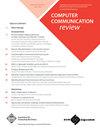Vasculitis of Vasa Vasorum and Aneurysm Formation in Kawasaki Disease: Predilection for Coronary Arteries Lesions
IF 2.8
4区 计算机科学
Q3 COMPUTER SCIENCE, INFORMATION SYSTEMS
引用次数: 0
Abstract
Backgrounds. The mechanism causing coronary artery lesions in Kawasaki disease (KD) has not yet been fully clarified. Objective. We hypothesized that the main coronary artery (MCA) segment perfused by the vasa vasorum (VV) arose from the atrial and ventricular branches of peripheral coronary arteries in the myocardium (Type 1 VV externa) is more prone to aneurysm formation than that perfused by Type 2 VV originated from the ostium. Methods and Results. We reviewed the coronary angiography and two-dimensional echocardiogram (2DE) data of KD patients in our hospital and measured the distances from the left coronary ostium to the proximal point of the aneurysm in the left MCA (D1) and to the MCA bifurcation (D2). We found that the ratio of the distances (D1/D2) was negatively correlated with the patients’ age of KD onset, indicating that longitudinal extension of the left MCA aneurysms coincided with the development of Type 1 VV externa. We performed a literature review of KD cases with extracardiac aneurysms and found that 15 patients also had giant aneurysms in the MCA. Also, 8 of 9 extracardiac aneurysm cases whose clear 2DE images were available in the reports, the giant MCA aneurysms seemed to have developed at positions immediately adjacent to the ostium. We assume that the giant coronary aneurysms might be a consequence of the coincidence of aneurysms in the MCA segments perfused by Type 1 and 2 VV externas and reflect a severe inflammation where Type 2 VV externa which is less susceptible to blood flow reduction than Type 1 VV externa is affected. Conclusions. Vasculitis in VV externa with the unique structure originating from and distributing most richly across coronary arteries might induce a vicious circle of hypoperfusion of VV externa and reduced coronary blood flow.川崎病的血管炎和动脉瘤形成:冠状动脉病变的偏好
背景。川崎病(KD)引起冠状动脉病变的机制尚未完全阐明。客观的我们假设,由起源于心肌中外周冠状动脉的心房和心室支的输精管(VV)灌注的主冠状动脉(MCA)段(1型VV外部)比由起源于窦口的2型VV灌注的段更容易形成动脉瘤。方法和结果。我们回顾了我院KD患者的冠状动脉造影和二维超声心动图(2DE)数据,并测量了从左冠状动脉口到左MCA动脉瘤近端的距离(D1)和到MCA分叉的距离(D2)。我们发现距离之比(D1/D2)与患者的KD发病年龄呈负相关,表明左MCA动脉瘤的纵向延伸与1型VV外部的发展相吻合。我们对患有心外动脉瘤的KD病例进行了文献回顾,发现15名患者的MCA中也有巨大动脉瘤。此外,在报告中可获得清晰2DE图像的9例心外动脉瘤病例中,有8例巨大的MCA动脉瘤似乎是在紧邻窦口的位置形成的。我们认为,巨大的冠状动脉瘤可能是1型和2型VV外动脉灌注的MCA段动脉瘤重合的结果,并反映了严重的炎症,其中2型VV-外动脉比1型VV-内动脉更不容易受到血流减少的影响。结论。VV外血管炎具有独特的结构,起源于冠状动脉,分布最丰富,可能会导致VV外灌注不足和冠状动脉血流量减少的恶性循环。
本文章由计算机程序翻译,如有差异,请以英文原文为准。
求助全文
约1分钟内获得全文
求助全文
来源期刊

ACM Sigcomm Computer Communication Review
工程技术-计算机:信息系统
CiteScore
6.90
自引率
3.60%
发文量
20
审稿时长
4-8 weeks
期刊介绍:
Computer Communication Review (CCR) is an online publication of the ACM Special Interest Group on Data Communication (SIGCOMM) and publishes articles on topics within the SIG''s field of interest. Technical papers accepted to CCR typically report on practical advances or the practical applications of theoretical advances. CCR serves as a forum for interesting and novel ideas at an early stage in their development. The focus is on timely dissemination of new ideas that may help trigger additional investigations. While the innovation and timeliness are the major criteria for its acceptance, technical robustness and readability will also be considered in the review process. We particularly encourage papers with early evaluation or feasibility studies.
 求助内容:
求助内容: 应助结果提醒方式:
应助结果提醒方式:


